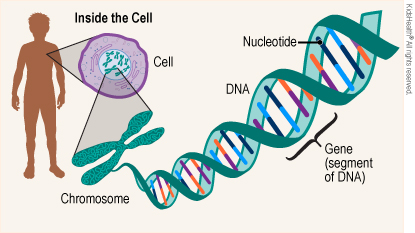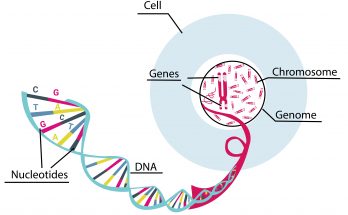The difference between genes and chromosomes is a fundamental concept in the study of genetics and molecular biology. Genes are specific segments of DNA that code for proteins and play a crucial role in defining the traits and functions of living organisms. Chromosomes, on the other hand, are larger structures within the cell’s nucleus that organise and manage DNA, facilitating efficient replication and proper distribution during cell division. This article explores the distinctions and functions of genes and chromosomes, shedding light on their crucial roles in heredity and cellular biology.
Table of Contents
Gene
- Definition: A gene is a segment of DNA that contains the code for a specific protein that functions in one or more types of cells in the body.
- Function: Genes are tasked with the synthesis of specific proteins that are essential for the structure and function of the body’s cells and organs.
- Structure: Genes are specific segments located within the DNA strand on chromosomes.
- Inheritance: Genes are the fundamental units of heredity and determine individual traits, such as eye colour or height.
Chromosome
- Definition: A chromosome is a thread-like structure composed of DNA and proteins found in the nucleus of every cell.
- Function: Chromosomes contain many genes and are critical for gene regulation and the proper distribution of DNA during cell division.
- Structure: Chromosomes are made up of DNA that is tightly coiled around proteins called histones to form a compact and organised entity.
- Inheritance: Chromosomes are passed from parents to offspring, carrying genes that determine unique traits and contribute to genetic diversity.
Key Differences Between Genes and Chromosomes in Tabular Format
| Aspect | Gene | Chromosome |
|---|---|---|
| Definition | Segments of DNA coding for specific proteins. | Structures containing DNA, organised in the nucleus. |
| Function | Produce specific proteins and regulate functions. | Manage DNA replication and distribution during cell division. |
| Structure | Segments within the DNA strand. | Composed of tightly coiled DNA and histones. |
| Inheritance | Determine specific traits. | Carry genes and ensure genetic stability. |
Detailed Explanation of Differences Between Genes and Chromosomes

Definition
- Gene: A gene acts as a blueprint for protein production. It contains the necessary information to build specific proteins, which in turn influence the body’s structure (like muscle fibres) and functions (such as enzyme activity). Genes are the fundamental instructional guides that dictate both the physical and biochemical characteristics of organisms.
- Chromosome: A chromosome serves as the structural unit within the cell that organises and safeguards the DNA molecules. Chromosomes ensure that DNA is accurately replicated and distributed during the process of cell division, thus maintaining genetic continuity across generations.
Composition
- Gene: Genes consist of specific sequences of DNA nucleotides. These sequences encode the amino acid sequence of proteins, following the rules of the genetic code. Each set of three nucleotides, called a codon, specifies a particular amino acid, which are the building blocks of proteins.
- Chromosome: Chromosomes are composed of DNA and histone proteins. Histones help package the long DNA molecules into a more compact, manageable form, which also plays a critical role in regulating access to genetic information. This packaging is essential for fitting the DNA into the cell nucleus and for gene expression control.
Structure
- Gene: Genes are relatively small segments of the larger DNA molecule, each gene located specifically at a certain position on a chromosome. The length of a gene can vary greatly depending on the size of the protein it codes for.
- Chromosome: Chromosomes are larger structures visible under a microscope during cell division. Each chromosome is a single, continuous DNA molecule that can carry hundreds to thousands of genes. The DNA in chromosomes is highly coiled around histones and other proteins to form chromatin.
Also Check – 8 Key Differences Between Plasmid DNA and Chromosomal DNA
Location
- Gene: Genes are found on chromosomes within the nucleus of every cell. The specific location of a gene on a chromosome is known as its locus, which can be critical for understanding genetic linkage and inheritance patterns.
- Chromosome: Chromosomes are located in the nucleus of cells. They become highly condensed and visible as distinct structures during the metaphase stage of cell division, allowing them to be studied and characterised through techniques such as karyotyping.
Function
- Gene: The primary function of genes is to direct the synthesis of proteins. These proteins carry out most of the work in cells, from speeding up biochemical reactions as enzymes to acting as structural components of cells and tissues.
- Chromosome: Chromosomes play a crucial role in ensuring that DNA is correctly replicated and accurately distributed to new cells during division. They facilitate the equal division of genetic material, a process vital for growth, repair, and reproduction in organisms.
Role in Genetics
- Gene: Each gene influences specific traits or characteristics of an organism, such as eye colour, blood type, or susceptibility to certain diseases. Genes can be dominant or recessive, and interactions between different genes and environmental factors determine the organism’s phenotype.
- Chromosome: Chromosomes are key to genetic inheritance. They are studied in genetic testing and forensic science to understand genetic disorders, familial relationships, and evolutionary biology. Chromosomes carry genetic material from one generation to the next, affecting the genetic makeup and variability of populations.
Also Check – 6 Important Differences Between DNA and Chromosomes
Also Check -6 Key Differences Between DNA and Genes
FAQs on Genes and Chromosomes
What is the primary function of a gene?
- Answer: The primary function of a gene is to provide instructions for synthesising proteins, which are essential for the various functions and structures in an organism.
Describe the structure of a chromosome.
- Answer: A chromosome is made up of DNA that is tightly coiled around histone proteins, forming a structure that condenses further during cell division to become visible under a microscope as distinct entities.
Explain the role of chromosomes in genetic inheritance.
- Answer: Chromosomes play a crucial role in genetic inheritance by ensuring that DNA is accurately replicated and properly distributed to daughter cells during cell division. This accurate distribution is essential for the transmission of genetic information from one generation to the next.
What is the significance of the location of a gene on a chromosome?
- Answer: The specific location of a gene on a chromosome, known as its locus, is significant for genetic linkage and inheritance patterns. It determines the gene’s relative position to other genes, affecting the probability of these genes being inherited together.
Also Check – Penn Scientists Create Novel Technique to Form Human Artificial Chromosomes
How do histones relate to chromosomes?
- Answer: Histones are proteins around which DNA is wrapped, helping to package DNA into a more compact, manageable form known as chromatin. This structure forms the basis of chromosomes and plays a role in gene regulation by controlling access to DNA.
What are the differences between gene expression and chromosome structure during cell division?
- Answer: Gene expression involves the process by which information from a gene is used to synthesise proteins, whereas chromosome structure during cell division involves condensation of chromatin into visible chromosomes to ensure DNA is evenly divided between daughter cells.
Describe how chromosomes facilitate gene regulation.
- Answer: Chromosomes facilitate gene regulation by altering the structure of chromatin. This alteration can make certain regions of DNA more or less accessible to the machinery that synthesises RNA and, subsequently, proteins, effectively turning genes on or off.
Explain the relationship between genes and proteins.
- Answer: Genes contain the coded instructions for making proteins. Each gene’s sequence of DNA bases dictates the sequence of amino acids in a protein, determining the protein’s structure and function within the body.
What is the role of chromosomes in cell division?
- Answer: During cell division, chromosomes ensure that DNA is correctly replicated and each new cell receives an accurate copy of the genetic material. This is crucial for maintaining genetic stability and preventing disorders.
How can mutations in genes or chromosome structures affect an organism?
- Answer: Mutations in genes can alter the protein that is produced, potentially leading to malfunctioning proteins that cause disease. Mutations in chromosome structure, such as deletions, duplications, or rearrangements, can affect many genes simultaneously and lead to complex genetic disorders or developmental issues.



